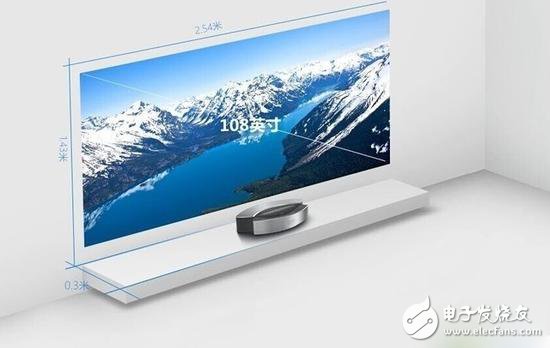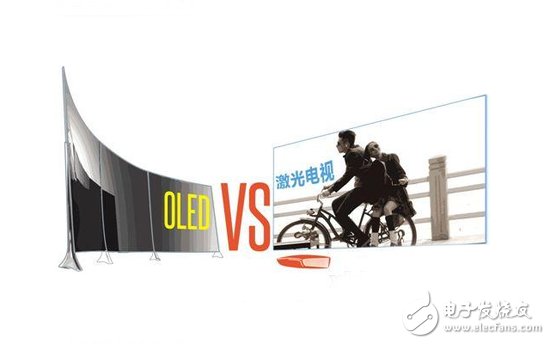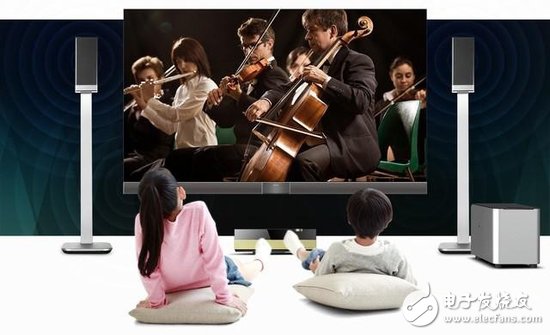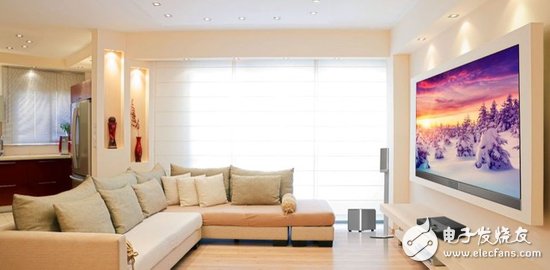The laser TV has a large screen and shocking effect compared with the traditional TV, showing the price-performance advantage all the way to the yangko, the market sales trend continues to rise. As a leader in the field of smart TV, Hisense released a 100-inch 4K laser TV in North America last week, which is hailed as a revolutionary next-generation TV display technology, which shows that the concept of laser TV has been deeply rooted in the hearts of the people. So, what is laser TV? What is the difference and advantage compared to traditional oled TVs and projectors?
What is laser TV?
The laser television uses a semiconductor pumped solid-state laser working substance to generate a continuous laser of three wavelengths of red, green and blue as a light source of a color laser television, and controls a three-primary laser scanning image through a television signal.
Compared with traditional TVs, laser TVs have the following characteristics: (1) Laser TVs have bright colors, high brightness, flexible screen sizes, and vivid images can be projected onto various material surfaces or even curved surfaces. This system can also be adapted to all of the TV standards currently in use, namely PAL, NC, SECAM VGA or HDTV. (2) Laser TV is the strongest competitor in the 21st century TV market. It is simpler and more colorful than plasma TV. The brightness of laser TV is brighter than that of large-screen LCD TV, and it is not subject to the direction of view. Sexual influence. (3) The laser is 100% monochromatic light, and the red, green and blue lights of the laser TV are separately modulated, and the color effect is very ideal. Its room temperature life is generally up to 100,000 hours, and the room temperature life estimated by the high temperature aging test can reach millions of hours, so it is a long life and high reliability product. (4) Laser TV can be developed into a multi-functional product for ultra-large screen TV, film and projection.
The working principle of laser TV is also easy to understand. It mainly consists of a laser, a light deflector and a screen. The laser TV is mainly composed of a laser, a light deflector and a screen. The semiconductor pumped solid-state laser is used to generate R (red), G (green), B (blue) continuous, three-wavelength laser light sources, and the R is controlled by a television signal. , G, B laser scanning images.

How laser TV works
Laser TV vs OLED, which is better?OLED is called the next-generation display technology, and now the OLED market camp is gradually expanding. LG Display is cooperating with LG Electronics, Changhong, Skyworth, Haier and Konka to speed up the popularization of OLED TV (parameter picture articles). Because of the self-illuminating properties, it brings a purer black, thinner design, more realistic color expression and 5000 times faster response than LCD. Image quality is generally considered superior to LCD TV. However, the problem of high power consumption, low brightness and short life of OLED TVs still exists, and the high cost is also considered to be one of the reasons hindering the rapid development of OLED TVs. In the development process of clarity and intelligence, although the OLED push technology is constantly upgrading, when large-size TVs of 60 inches or more gradually become mainstream, OLED TVs have to face an embarrassing situation: the relative cramps of the living room Contradictions with the absolute increment of the screen, in order to enjoy the home theater-like enjoyment, the premise is to have a larger screen.

Laser TV VS OLED TV, but the large-size LCD and OLED TVs above 60 inches have a safety line of sight of at least 4 meters. Considering the common specifications of today's homes, it is almost impossible to see the cinematic effect in the living room. The emergence of laser TV can be said to directly hit such a pain point. A 100-inch laser TV is placed in the living room, which can be viewed safely with a viewing distance of 4 meters without feeling uncomfortable.

The safety line of sight of LCD and OLED TVs of 60 inches or more is at least 4 meters. If it is only to meet the demand of watching large screens at close range, it is obviously not enough to become the advantage of laser TV instead of OLED TV. Although OLED has the advantages of thin thickness and no radiation, the low brightness and short life, and the difficulty of realizing large screens still plague the development of OLED TV.

The safety line of sight of LCD and OLED TVs of 60 inches or more is at least 4 meters. Because laser TVs use R, G and B laser sources, compared with OLEDs, laser TVs have the advantages of high color purity and large color gamut. Because the laser has good monochromaticity and high color purity, it can achieve higher color gamut. Therefore, laser TV has higher contrast and saturation than other types of TVs, and a larger color gamut, which shows the effect of making the color more vivid. ,More real. At the same time, the zoom lens can zoom in or out as needed, and the screen size is more variable and flexible. More than 50% of the power consumption of OLED TVs comes from the screen. The larger the screen, the greater the power consumption, and the higher the screen size, the higher the requirements for materials, processes and yields, resulting in a rapid price increase. Laser TVs reduce power consumption to 1/2 to 1/3 of similar-size OLED TVs. There is no direct correlation between body size and screen size, and flexibility is even stronger.
Laser TV VS projector, which is better?There are many types of projectors, such as telephoto, short focus, high brightness, commercial education, etc. The projection of different parameters is aimed at a completely different user group. For example, a short focal length projector is suitable for indoors with a small space, a high brightness projector is suitable for watching movies, and is suitable for presentation in brightly lit areas.
In addition, the projector is flexible in use and has a high degree of freedom. We all know that home projectors are usually small in size and easy to move. As long as the space is right, there is no fixed placement requirement. Just find a white wall or place the screen in another place. If in the commercial sector, the higher degree of freedom will be more obvious. If the company holds a meeting, it is only necessary to move the projector to a different meeting room and project the picture onto a pure white wall. Laser TV (parameter picture article) can't do this.

The projector is flexible in use and has a high degree of freedom.
In addition, the projector market is very mature, not only the number of products, but also the price range is very detailed. For example, 1080p projectors are all around 1,000 yuan, and some are 4000~6000 yuan, and there are many high-end products with prices of 10,000 yuan +. Consumers can choose the right products according to their actual needs and economic budget. .
But home projectors also have two shortcomings: one is that the life of the bulb is limited, replacing the bulb is time consuming and laborious; the second is that it must be effective in low light scenes. Especially the second point, almost cut off the possibility that the projector is ready to use like a traditional TV.

Household projector light bulb
The projection part of the laser TV uses a laser light source, which has the characteristics of high light quality and long life of the light source, and does not need to worry about the trouble of replacing the light bulb, and has the additional advantages of high contrast, high color gamut and high brightness.
Second, the biggest feature of laser TV screens is the very high contrast level. Through the optical reflection and absorption design, the reflection of ambient light is minimized, so that it can be raised to a higher contrast, and the picture under light conditions is not very pale, so it can be used during the day or under the light.
In addition, since the projector usually uses the image directly on a white wall or a curtain, the quality of the white wall or curtain, including light reflectivity and white balance, will affect the final projection. The laser TV will be equipped with a special screen, which can effectively resist the ambient light interference compared with the ordinary projection screen, so that the screen effect is better, so that the projected image can be reflected to the human eye as much as possible.
Through the above comparison, we can see that laser TV and projector have their own advantages and disadvantages. The biggest shortcoming of the projector is that the display effect is slightly worse, but there is a certain advantage in the degree of freedom. In most cases, the display effect of laser TV is better than that of the projector. The display effect on the large-size screen is better than LCD and OLED TV. The price is also much cheaper than the LCD and OLED TV of the same size. It can be said that the laser TV Found a good balance between LCD, OLED TV and projector.
In addition, the laser TV takes up a small space, can be regarded as an ultra-short-throw projection from the use distance, and can be projected vertically upwards, and can be placed on a TV cabinet close to the wall to deliver a large-sized screen, which is also the largest with the projector product. The difference is also the reason why the experience is better than the projector. For example, when using a projector, the screen to be projected is large enough, and the projector and the screen are required to be opened at a certain distance, and once someone passes between the projector and the screen during use, not only the viewing effect is greatly affected, but also The glare in the projector can also cause some damage to the passing human eye. However, since the laser TV is vertically "sticked" to the bottom of the screen, this situation is completely avoided.

Household projector light bulb
However, this also brings the shortcomings of the laser TV, the position of the body and the screen can not move freely, otherwise the screen trapezoidal distortion will appear, and the adjustment is much more complicated than the projection.
DADNCELL 1.5V AAA alkaline batteries are more suitable for long-lasting continuous discharge and high-performance power consumption equipment because of their unique internal component structure, coupled with better battery materials, improved power capacity and electrical performance, and the same model of DADNCELL 1.5V AAA alkaline cell capacity and discharge time, Alkaline battery capacity and discharge time are 4-7 times that of ordinary batteries, and the gap in power discharge performance at high and low temperature is even wider.
At present, all types of cells developed by DADNCELL Labs do not involve any heavy metals in production, are green and can be disposed of with domestic waste.
DADNCELL 1.5V AAA battery advocates a more comfortable and smooth power supply experience for household appliances. Alkaline zinc-manganese dry battery series is suitable for various common household electronic equipment instruments such as smart door locks, infrared thermometers, cameras, flash lights, razors, electric toys, instruments, high-power remote controls, Bluetooth wireless mouse keyboards, etc.
1.5V Lr20(D) Alkaline Cells,1.5V Lr20 Alkaline Cells For Infrared Temperature Gun,Batteries Camera Instruments And Meters,Lr20 Suitable For Intelligent Door Locks
Shandong Huachuang Times Optoelectronics Technology Co., Ltd. , https://www.dadncell.com